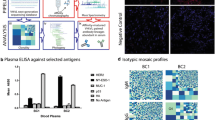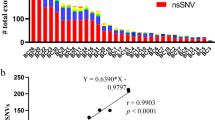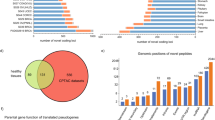Abstract
The identification of tumor antigens capable of eliciting an immune response in vivo may be an effective method to identify therapeutic cancer targets. We have developed a method to identify such antigens using frozen tumor-draining lymph node samples from breast cancer patients. Immune responses in tumor-draining lymph nodes were identified by immunostaining lymph node sections for B-cell markers (CD20&CD23) and Ki67 which revealed cell proliferation in germinal center zones. Antigen-dependent somatic hypermutation (SH) and clonal expansion (CE) were present in heavy chain variable (VH) domain cDNA clones obtained from these germinal centers, but not from Ki67 negative germinal centers. Recombinant VH single-domain antibodies were used to screen tumor proteins and affinity select potential tumor antigens. Neuroplastin (NPTN) was identified as a candidate breast tumor antigen using proteomic identification of affinity selected tumor proteins with a recombinant VH single chain antibody. NPTN was found to be highly expressed in approximately 20% of invasive breast carcinomas and 50% of breast carcinomas with distal metastasis using a breast cancer tissue array. Additionally, NPTN over-expression in a breast cancer cell line resulted in a significant increase in tumor growth and angiogenesis in vivo which was related to increased VEGF production in the transfected cells. These results validate NPTN as a tumor-associated antigen which could promote breast tumor growth and metastasis if aberrantly expressed. These studies also demonstrate that humoral immune responses in tumor-draining lymph nodes can provide antibody reagents useful in identifying tumor antigens with applications for biomarker screening, diagnostics and therapeutic interventions.






Similar content being viewed by others
Explore related subjects
Discover the latest articles and news from researchers in related subjects, suggested using machine learning.References
Agarwal A, Munoz-Najar U, Klueh U, Shih SC, Claffey KP (2004) N-acetyl-cysteine promotes angiostatin production and vascular collapse in an orthotopic model of breast cancer. Am J Pathol 164(5):1683–1696
Aihara K, Yamada K, Murakami H, Nomura Y, Omura H (1988) Production of human–human hybridomas secreting monoclonal antibodies reactive to breast cancer cell lines. In Vitro Cell Dev Biol 24(9):959–962
Angelin-Duclos C, Cattoretti G, Lin KI, Calame K (2000) Commitment of B lymphocytes to a plasma cell fate is associated with Blimp-1 expression in vivo. J Immunol 165(10):5462–5471
Annibali NV, Baldi A (1997) Characterization of the ETSA-21 antigen, a glycosylphosphatidyl-inositol anchor glycoprotein identified in breast cancer cells using monoclonal antibody B21. Hybridoma 16(2):139–145
Bernstein HG, Smalla KH, Bogerts B, Gordon-Weeks PR, Beesley PW, Gundelfinger ED, Kreutz MR (2007) The immunolocalization of the synaptic glycoprotein neuroplastin differs substantially between the human and the rodent brain. Brain Res 1134(1):107–112
Chin Y, Janseens J, Vandepitte J, Vandenbrande J, Opdebeek L, Raus J (1992) Phenotypic analysis of tumor-infiltrating lymphocytes from human breast cancer. Anticancer Res 12(5):1463–1466
Coronella-Wood JA, Hersh EM (2003) Naturally occurring B-cell responses to breast cancer. Cancer Immunol Immunother 52(12):715–738
Coronella JA, Spier C, Welch M, Trevor KT, Stopeck AT, Villar H, Hersh EM (2002) Antigen-driven oligoclonal expansion of tumor-infiltrating B cells in infiltrating ductal carcinoma of the breast. J Immunol 169(4):1829–1836
Cote RJ, Morrissey DM, Houghton AN, Beattie EJ Jr, Oettgen HF, Old LJ (1983) Generation of human monoclonal antibodies reactive with cellular antigens. Proc Natl Acad Sci USA 80(7):2026–2030
Empson RM, Buckby LE, Kraus M, Bates KJ, Crompton MR, Gundelfinger ED, Beesley PW (2006) The cell adhesion molecule neuroplastin-65 inhibits hippocampal long-term potentiation via a mitogen-activated protein kinase p38-dependent reduction in surface expression of GluR1-containing glutamate receptors. J Neurochem 99(3):850–860
Freire T, Lo-Man R, Piller F, Piller V, Leclerc C, Bay S (2006) Enzymatic large-scale synthesis of MUC6-Tn glycoconjugates for antitumor vaccination. Glycobiology 16(5):390–401
Goldstein NI, Nagle R, Villar H, Hersh E, Fisher PB (1990) Isolation and characterization of a human monoclonal antibody which reacts with breast and colorectal carcinoma. Anticancer Res 10(6):1491–1500
Grekou AN, Toliou T, Stravoravdi P, Patakiouta F, Tsoukalas T, Pinakidis M, and Keramidas G (1996) Correlation of apoptosis with the distribution and composition of lymphocytic infiltrate in human breast carcinomas. Anticancer Res 16(6C):3991–3995
Hadden JW (1999) The immunology and immunotherapy of breast cancer: an update. Int J Immunopharmacol 21(2):79–101
Hamers-Casterman C, Atarhouch T, Muyldermans S, Robinson G, Hamers C, Songa EB, Bendahman N, Hamers R (1993) Naturally occurring antibodies devoid of light chains. Nature 363(6428):446–448
Harada Y, Ohuchi N, Masuko T, Funaki Y, Mori S, Satomi S, Hashimoto Y (1996) Characterization of a new breast cancer-associated antigen and its relationship to MUC1 and TAG-72 antigens. Tohoku J Exp Med 180(3):273–288
Holliger P, Hudson PJ (2005) Engineered antibody fragments and the rise of single domains. Nat Biotechnol 23(9):1126–1136
Holt LJ, Herring C, Jespers LS, Woolven BP, Tomlinson IM (2003) Domain antibodies: proteins for therapy. Trends Biotechnol 21(11):484–490
Hunter RL, Ferguson DJ, Coppleson LW (1975) Survival with mammary cancer related to the interaction of germinal center hyperplasia and sinus histiocytosis in axillary and internal mammary lymph nodes. Cancer 36(2):528–539
Iacono KT, Brown AL, Greene MI, Saouaf SJ (2007) CD147 immunoglobulin superfamily receptor function and role in pathology. Exp Mol Pathol 83(3):283–295
Imam A, Drushella MM, Taylor CR, Tokes ZA (1985) Generation and immunohistological characterization of human monoclonal antibodies to mammary carcinoma cells. Cancer Res 45(1):263–271
Kjeldsen TB, Rasmussen BB, Rose C, Zeuthen J (1988) Human–human hybridomas and human monoclonal antibodies obtained by fusion of lymph node lymphocytes from breast cancer patients. Cancer Res 48(11):3208–3214
Lampert IA, Van Noorden S, Wotherspoon AC (2005) Centrocytoid plasma cells of the germinal center. Appl Immunohistochem Mol Morphol 13(2):124–131
Langnaese K, Beesley PW, Gundelfinger ED (1997) Synaptic membrane glycoproteins gp65 and gp55 are new members of the immunoglobulin superfamily. J Biol Chem 272(2):821–827
Langnaese K, Mummery R, Gundelfinger ED, Beesley PW (1998) Immunoglobulin superfamily members gp65 and gp55: tissue distribution of glycoforms. FEBS Lett 429(3):284–288
Lossos IS, Tibshirani R, Narasimhan B, Levy R (2000) The inference of antigen selection on Ig genes. J Immunol 165(9):5122–5126
Nzula S, Going JJ, Stott DI (2003) Antigen-driven clonal proliferation, somatic hypermutation, and selection of B lymphocytes infiltrating human ductal breast carcinomas. Cancer Res 63(12):3275–3280
Pancino G, Osinaga E, Charpin C, Mistro D, Barque JP, Roseto A (1991) Purification and characterisation of a breast-cancer-associated glycoprotein not expressed in normal breast and identified by monoclonal antibody 83D4. Br J Cancer 63(3):390–398
Phoenix KN, Vumbaca F, Claffey KP (2008) Therapeutic metformin/AMPK activation promotes the angiogenic phenotype in the ERalpha negative MDA-MB-435 breast cancer model. Breast Cancer Res Treat. doi:10.1007/s10549-008-9916-5
Posner MR, Elboim HS, Tumber MB, Wiest PM, Tibbetts LM (1991) An IgG human monoclonal antibody reactive with a surface membrane antigen expressed on malignant breast cancer cells. Hum Antibodies Hybridomas 2(2):74–83
Rahman ZS, Rao SP, Kalled SL, Manser T (2003) Normal induction but attenuated progression of germinal center responses in BAFF and BAFF-R signaling-deficient mice. J Exp Med 198(8):1157–1169
Rughetti A, Turchi V, Ghetti CA, Scambia G, Panici PB, Roncucci G, Mancuso S, Frati L, Nuti M (1993) Human B-cell immune response to the polymorphic epithelial mucin. Cancer Res 53(11):2457–2459
Sarfati M (1997) Leucocyte typing VI. Garland Publishing Inc., New York, pp 144–147
Sblattero D, Bradbury A (1998) A definitive set of oligonucleotide primers for amplifying human V regions. Immunotechnology 3(4):271–278
Schlom J, Wunderlich D, Teramoto YA (1980) Generation of human monoclonal antibodies reactive with human mammary carcinoma cells. Proc Natl Acad Sci USA 77(11):6841–6845
Scholzen T, Gerdes J (2000) The Ki-67 protein: from the known and the unknown. J Cell Physiol 182(3):311–322
Shih SC, Mullen A, Abrams K, Mukhopadhyay D, Claffey KP (1999) Role of protein kinase C isoforms in phorbol ester-induced vascular endothelial growth factor expression in human glioblastoma cells. J Biol Chem 274(22):15407–15414
Simsa P, Teillaud JL, Stott DI, Toth J, Kotlan B (2005) Tumor-infiltrating B cell immunoglobulin variable region gene usage in invasive ductal breast carcinoma. Pathol Oncol Res 11(2):92–97
Smalla KH, Matthies H, Langnase K, Shabir S, Bockers TM, Wyneken U, Staak S, Krug M, Beesley PW, Gundelfinger ED (2000) The synaptic glycoprotein neuroplastin is involved in long-term potentiation at hippocampal CA1 synapses. Proc Natl Acad Sci USA 97(8):4327–4332
Tang Y, Nakada MT, Kesavan P, McCabe F, Millar H, Rafferty P, Bugelski P, Yan L (2005) Extracellular matrix metalloproteinase inducer stimulates tumor angiogenesis by elevating vascular endothelial cell growth factor and matrix metalloproteinases. Cancer Res 65(8):3193–3199
Tang Y, Nakada MT, Rafferty P, Laraio J, McCabe FL, Millar H, Cunningham M, Snyder LA, Bugelski P, Yan L (2006) Regulation of vascular endothelial growth factor expression by EMMPRIN via the PI3 K-Akt signaling pathway. Mol Cancer Res 4(6):371–377
Tsakraklides V, Olson P, Kersey JH, Good RA (1974) Prognostic significance of the regional lymph node histology in cancer of the breast. Cancer 34(4):1259–1267
Whitford P, George WD, Campbell AM (1992) Flow cytometric analysis of tumour infiltrating lymphocyte activation and tumour cell MHC class I and II expression in breast cancer patients. Cancer Lett 61(2):157–164
Yan L, Zucker S, Toole BP (2005) Roles of the multifunctional glycoprotein, emmprin (basigin; CD147), in tumour progression. Thromb Haemost 93(2):199–204
Yates JR 3rd, Eng JK, McCormack AL, Schieltz D (1995) Method to correlate tandem mass spectra of modified peptides to amino acid sequences in the protein database. Anal Chem 67(8):1426–1436
Zhang J, Li Q, Nguyen TD, Tremblay TL, Stone E, To R, Kelly J, Roger MacKenzie C (2004) A pentavalent single-domain antibody approach to tumor antigen discovery and the development of novel proteomics reagents. J Mol Biol 341(1):161–169
Zheng HC, Takahashi H, Murai Y, Cui ZG, Nomoto K, Miwa S, Tsuneyama K, Takano Y (2006) Upregulated EMMPRIN/CD147 might contribute to growth and angiogenesis of gastric carcinoma: a good marker for local invasion and prognosis. Br J Cancer 95(10):1371–1378
Acknowledgments
This work was supported by NIH:NCI IMAT grant, CA114489 (KPC) and The Patrick and Catherine Weldon Donaghue Foundation (KPC). Many thanks to Nancy Ryan for her technical assistance in histology and immunohistochemistry.
Author information
Authors and Affiliations
Corresponding author
Rights and permissions
About this article
Cite this article
Rodriguez-Pinto, D., Sparkowski, J., Keough, M.P. et al. Identification of novel tumor antigens with patient-derived immune-selected antibodies. Cancer Immunol Immunother 58, 221–234 (2009). https://doi.org/10.1007/s00262-008-0543-0
Received:
Accepted:
Published:
Issue Date:
DOI: https://doi.org/10.1007/s00262-008-0543-0




